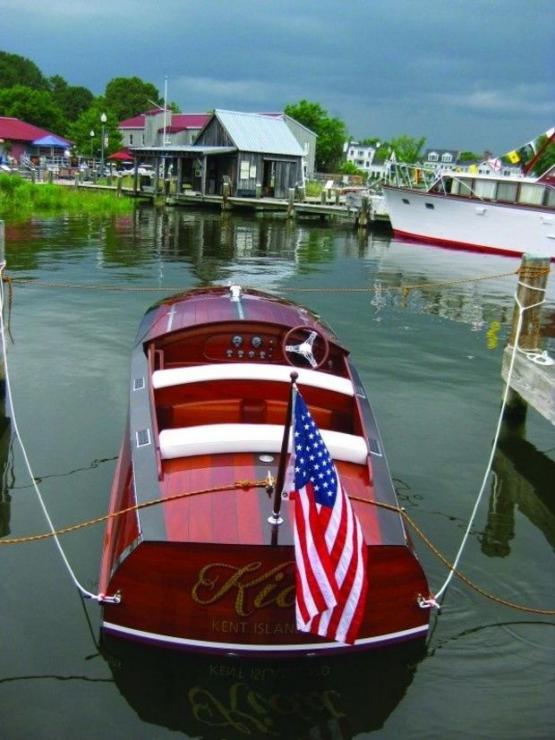 A Variety of Boats
A Variety of Boats
What types of boats attract you? Do you prefer runabouts or cruisers? Cuddy cabins or fishing boats? Fiberglass or wood? The once-a-year show in St. Michaels will have them all, plus a full festival of events, vendors, seminars, maritime-themed artists and craftsmen, plus music and food.
This year the Chesapeake Bay Chapter of the American Classic Boat Society (ACBS) hosts some unique, rare, and special boats. The festival spreads across the nine football fields of the Chesapeake Bay Maritime Museum (CBMM). You don’t want to miss this Maryland event, now in its 28th year!
For the first time, a rare Chris-Craft Cobra will be at this show. It’s the Chris-Craft with the gold tail fin, a single cockpit boat inside a distinctive wooden hull that starts off with a bow that splits the waves and tapers off to nothing at the stern. This is one of only 106 boats in this limited edition model made by Chris-Craft.
Another Chris-Craft runabout, the fiberglass XK–19 is also scheduled for this year’s event. This special boat shows styling and innovative design lines that set a standard in the early ‘70s for future Chris-Craft runabouts. Recently restored by Chad Brenner’s company, Classic Restoration and Supply, in Philadelphia, PA, she has a Jim Wynne-designed hull. Known for his international boat racing work, Wynne fashioned a 24-degree deep-vee hull for the XK-19 for great handling, ride, and high speed in Bay chop as well as offshore. Chris-Craft’s head of design, Dick Avery is credited with this boat’s smart above-the-waterline styling.
Now for the in-water cruisers at this event, many of which visitors can board, after asking permission, on Saturday, June 20. If you’re a fan of the Chris-Craft brand, expect to see wood, fiberglass, and even metal cabin cruisers. One of the most popular yachts is the 57-foot Constellation. Chris-Craft built 262 boats in this model. Most of them were priced around $1/foot in length when they were first sold.
This annual show has showcased yachts from famous and rare brands such as Trumpy, the ex-Governor’s yacht, Burgers, Rybovich, Wheeler, Owens, Cruis Along, Red Bank, and Mathews. These boats rarely attend other ACBS shows since many shows can’t accommodate the in-water yachts. This is just one more feature that makes this Classic Boat Show special.
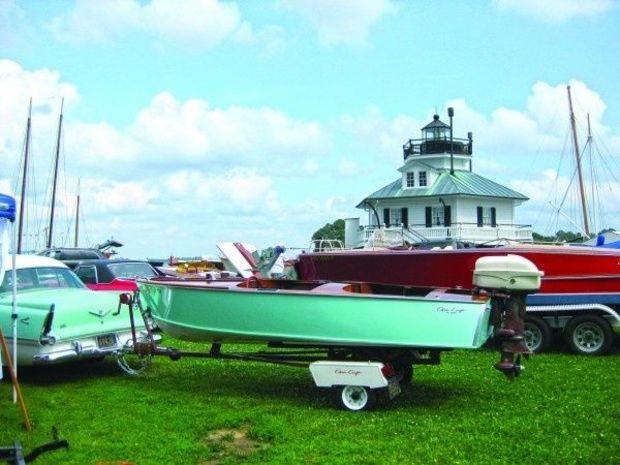
Now, back to runabouts: other boat brands that come from near and far to display at this Maryland June Festival are Lyman, Century, Higgins, Shepherd, Glastron, Glasspar, Cobalt, Sea Mac, Whirlwind, Checkmate, De Siva, Dodge, Garwood, Trojan, Mastercraft, Grady White, and Aristocraft. Last but not least, you’ll see a cross-section of collectible classic boats representing several other categories: daily use boats, fishing boats, tugs, launches, the Bay-built deadrise, race boats, skiffs, and a variety of “one-off” boats with creative features.
To plan your trip to the festival, check out the CBMM website for hours and details. You’ll also find a list of the festival’s maritime vendors featured in the Arts at Navy Point when you visit
chesapeakebayacbs.org
And if you have a boat you’d like to display, contact Ray Glenn at (410) 867-7853 to register.
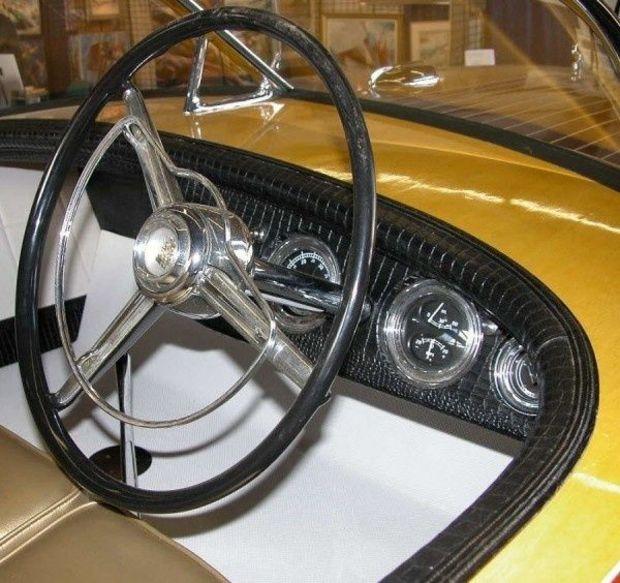 Chris-Craft Cobra, the Classic Boat Show's Top Dog
Chris-Craft Cobra, the Classic Boat Show's Top Dog
This Cobra is the Chris-Craft boat model that gets the adrenalin pumpin’! She will be on display at the Antique and Classic Boat Show & Festival June 19-20.
The Cobra model Chris-Craft is one of the most recognizable “wow” boats ever offered for sale in the long history of wooden boats. Chris-Craft made the Cobra its image boat after World War II. It wanted to be
the boat builder for every man, woman, and family in the world. Across a wide mix of boat models, this design was selected to attract buyers with its “gotta have it, can’t live without it” appeal. She was designed to turn heads on the water or at a boat show.
Chris-Craft decided that the profit made from its other models would cover whatever this Cobra would cost to build and market. In other words, she was one attractive loss-leader. Chris-Craft figured it spent so much on this boat’s development that it would just break even after making 100 boats. The factory built 106 Cobras and stopped.
For the underwater hull shape, Chris-Craft used the naval architectural lines of one of its existing boat models as the boat’s running surface. Those Chris-Craft lines had already sold 503 hulls.
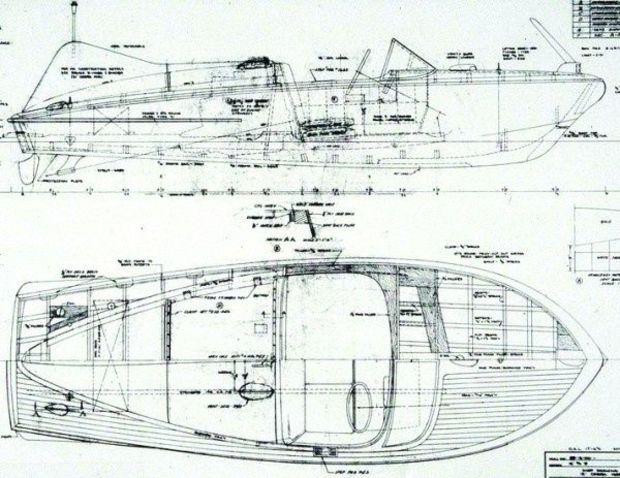
To that underwater running surface they styled a sleek, curvy, bright-finished planked mahogany boat that started at the bow as high, wide, and purposeful and then gracefully tapered its aft to nothing at the transom. Next, Chris-Craft took out the back seat. Then it added a “Chris-Craft” gold fin. The final addition was alligator upholstery.
This boat is rare. Chris-Craft only made Cobras in two lengths for about eight months in 1955. The gold fin, the single seat cockpit, the quality and sparkle of the hull, interior, and detailing all make for a special boat.
That gold fin was made from fiberglass at a time when Chris-Craft was the largest wooden boat builder in the world and just starting to use fiberglass as a boat building material. The fiberglass fin was made in one factory and the wood hull and deck in another. When mated together for final assembly, many gold fins did not fit their intended boat hulls. It is said that several fins were tried on most boats, so owners and restorers may find that the numbers on the fin and the boat hull probably don’t match.
The deck is mahogany planked and stained natural with a blond accent king plank as well as the decking around the gold fin. Like most runabouts from this time frame, the actual planks are wider than the white lines suggest to your eye. Grooves were made in the wider deck planks and these were striped with white paint, usually after the last of many coats of varnish was thoroughly dry. The hull is also made from Chris-Craft spec-grade mahogany wood planked over an understructure of a harder wood frame.
The boat bottom was double planked with a thin layer of planking going on first. Next, a canvas was stretched over that inner planking and that was brushed or soaked with lead. Next came the outer planking. This is the layer you see. It is thicker (between the two layers of planking and the canvas, the bottom is 9/16 inch thick). The boat was then protected with copper-bronze bottom paint.
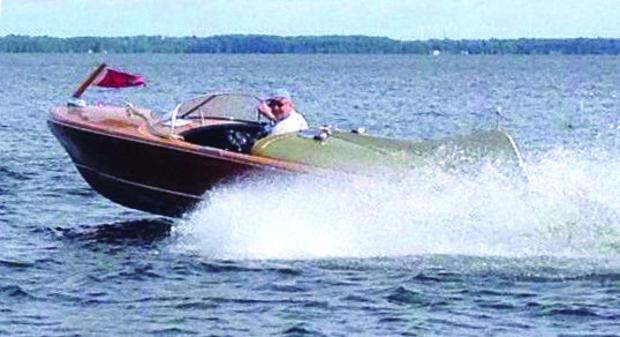
The side planking is done in a different manner. First, a small batten (think of a small, narrow strip of wood) is screwed to each boat frame. Then the side planks are screwed to these battens. Look for the screw heads by looking at the round plugs along the finished planking. Remember, frames run athwartships (across a boat) and the battens and planking run lengthwise. The sides are just this single thickness of planking that is 7/16 inch thick, backed up with those battens at each plank seam. This planking method used by Chris-Craft is often called batten seam construction.
Engine choices were many. They ranged from Chris-Craft-made and branded engines to a Chrysler Hemi. Another option was a special dual four-barrel carburetor Cadillac engine that made 285 horsepower, supplied by Cal Connell, a Detroit Cadillac car dealer. His marine engine company became Crusader Marine. [On a side note, Cal was the navigator for movie star Tyrone Powers during WW II in the South Pacific.]
Chris-Craft Cobras have a top speed from about 40 miles per hour to 55 mph depending on the engine selection. All the boats were made as straight-shaft, traditional inboard boats, but over the years a few have been re-powered and fitted with a V-drive. As the shaft angle is less with the V-drive, these boat run even faster. The Cobra seems to be a “wow” boat under any conditions.
Saturday, June 20: Boating Seminars
Look for a posted list of Saturday’s seminars about boats, boating, and all things nautical at the Festival information desk on the grounds of CBMM. Saturday, June 20 is the day for informative talks, slide shows, and hand-outs at the Antique and Classic Boat festival.
The seminar presentations are held inside the CBMM’s Steamboat Building, where comfortable chairs, microphones, and a large screen make it easy to attract nationwide experts. Enjoy this opportunity to talk with like-minded boating enthusiasts, take a break from the summer sun, and ask the speakers about topics that interest you.
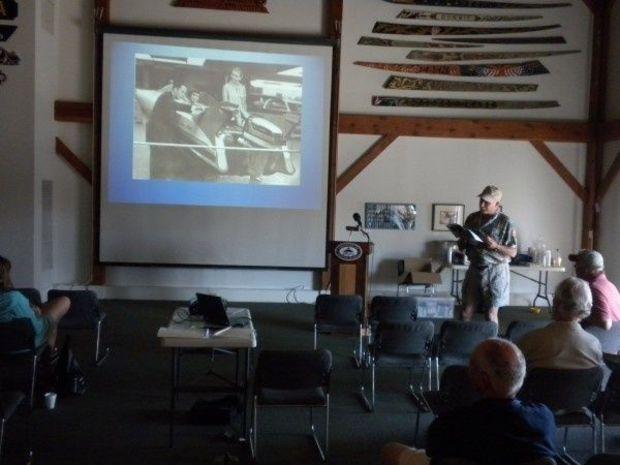
The presenters and topics are varied. They often include a mix of small boat designers, boating writers, boat builders, engine mechanics, and experts on certain brands/styles of boats. It’s also a great opportunity to pick up how-to information about boating, boating safety, and many other topics. Different experts are invited each year, often based on attendees’ requests.
Previous years’ topics have included: the Pluses + Minuses of 5200 Bottoms, the Strength of Old Wood Found in Boats, the Top10 Collectible Fiberglass Boats, Varnish Choices and Varnishing Techniques for Best Success, and Using Epoxy for Boat Restoration
Presenters come from Maine, Michigan, Connecticut, and Florida, as well as from various Mid-Atlantic states to share their expertise.
How Can I Tell if I Have a Collectible Boat?
Collectible boats can be wood, fiberglass, or metal, or a combination of these materials. In addition to the hull’s material, the boat’s age is an important factor. There are four sub-categories of collectible boats that hinge on how old the boat is. Here is an idea of how “Collectible Boats” are defined by the International Antique and Classic Boat Society (ACBS):
Historic: any boat built up to and including 1918
Antique: any boat built between 1919 -1942, inclusive
Classic: any boat built between 1943-1975
Late Classic: for boats constructed between 1975 and the year 25 years prior to the current year.
Boats from these periods are typically limited production or “one-off” boats and can be: discovered at shows, used daily by watermen, enjoyed in their “as-found” condition (after years in a barn or boathouse), restored to “concourse” quality or show-winning status
Many classic runabouts are either a utility (an open cockpit design that allows walking-around room) or a cockpit boat with one, two, or three cockpits of seating space, separated by solid decking over the rest of the classic. Of course, there are exceptions to this broad classification.
The benefit of using collectible boats is the same as using new boats….
fun! You may turn more heads driving a classic boat, though!
by Chris “Seabuddy” Brown A Variety of Boats
What types of boats attract you? Do you prefer runabouts or cruisers? Cuddy cabins or fishing boats? Fiberglass or wood? The once-a-year show in St. Michaels will have them all, plus a full festival of events, vendors, seminars, maritime-themed artists and craftsmen, plus music and food.
This year the Chesapeake Bay Chapter of the American Classic Boat Society (ACBS) hosts some unique, rare, and special boats. The festival spreads across the nine football fields of the Chesapeake Bay Maritime Museum (CBMM). You don’t want to miss this Maryland event, now in its 28th year!
For the first time, a rare Chris-Craft Cobra will be at this show. It’s the Chris-Craft with the gold tail fin, a single cockpit boat inside a distinctive wooden hull that starts off with a bow that splits the waves and tapers off to nothing at the stern. This is one of only 106 boats in this limited edition model made by Chris-Craft.
Another Chris-Craft runabout, the fiberglass XK–19 is also scheduled for this year’s event. This special boat shows styling and innovative design lines that set a standard in the early ‘70s for future Chris-Craft runabouts. Recently restored by Chad Brenner’s company, Classic Restoration and Supply, in Philadelphia, PA, she has a Jim Wynne-designed hull. Known for his international boat racing work, Wynne fashioned a 24-degree deep-vee hull for the XK-19 for great handling, ride, and high speed in Bay chop as well as offshore. Chris-Craft’s head of design, Dick Avery is credited with this boat’s smart above-the-waterline styling.
Now for the in-water cruisers at this event, many of which visitors can board, after asking permission, on Saturday, June 20. If you’re a fan of the Chris-Craft brand, expect to see wood, fiberglass, and even metal cabin cruisers. One of the most popular yachts is the 57-foot Constellation. Chris-Craft built 262 boats in this model. Most of them were priced around $1/foot in length when they were first sold.
This annual show has showcased yachts from famous and rare brands such as Trumpy, the ex-Governor’s yacht, Burgers, Rybovich, Wheeler, Owens, Cruis Along, Red Bank, and Mathews. These boats rarely attend other ACBS shows since many shows can’t accommodate the in-water yachts. This is just one more feature that makes this Classic Boat Show special.
A Variety of Boats
What types of boats attract you? Do you prefer runabouts or cruisers? Cuddy cabins or fishing boats? Fiberglass or wood? The once-a-year show in St. Michaels will have them all, plus a full festival of events, vendors, seminars, maritime-themed artists and craftsmen, plus music and food.
This year the Chesapeake Bay Chapter of the American Classic Boat Society (ACBS) hosts some unique, rare, and special boats. The festival spreads across the nine football fields of the Chesapeake Bay Maritime Museum (CBMM). You don’t want to miss this Maryland event, now in its 28th year!
For the first time, a rare Chris-Craft Cobra will be at this show. It’s the Chris-Craft with the gold tail fin, a single cockpit boat inside a distinctive wooden hull that starts off with a bow that splits the waves and tapers off to nothing at the stern. This is one of only 106 boats in this limited edition model made by Chris-Craft.
Another Chris-Craft runabout, the fiberglass XK–19 is also scheduled for this year’s event. This special boat shows styling and innovative design lines that set a standard in the early ‘70s for future Chris-Craft runabouts. Recently restored by Chad Brenner’s company, Classic Restoration and Supply, in Philadelphia, PA, she has a Jim Wynne-designed hull. Known for his international boat racing work, Wynne fashioned a 24-degree deep-vee hull for the XK-19 for great handling, ride, and high speed in Bay chop as well as offshore. Chris-Craft’s head of design, Dick Avery is credited with this boat’s smart above-the-waterline styling.
Now for the in-water cruisers at this event, many of which visitors can board, after asking permission, on Saturday, June 20. If you’re a fan of the Chris-Craft brand, expect to see wood, fiberglass, and even metal cabin cruisers. One of the most popular yachts is the 57-foot Constellation. Chris-Craft built 262 boats in this model. Most of them were priced around $1/foot in length when they were first sold.
This annual show has showcased yachts from famous and rare brands such as Trumpy, the ex-Governor’s yacht, Burgers, Rybovich, Wheeler, Owens, Cruis Along, Red Bank, and Mathews. These boats rarely attend other ACBS shows since many shows can’t accommodate the in-water yachts. This is just one more feature that makes this Classic Boat Show special.
 Now, back to runabouts: other boat brands that come from near and far to display at this Maryland June Festival are Lyman, Century, Higgins, Shepherd, Glastron, Glasspar, Cobalt, Sea Mac, Whirlwind, Checkmate, De Siva, Dodge, Garwood, Trojan, Mastercraft, Grady White, and Aristocraft. Last but not least, you’ll see a cross-section of collectible classic boats representing several other categories: daily use boats, fishing boats, tugs, launches, the Bay-built deadrise, race boats, skiffs, and a variety of “one-off” boats with creative features.
To plan your trip to the festival, check out the CBMM website for hours and details. You’ll also find a list of the festival’s maritime vendors featured in the Arts at Navy Point when you visit chesapeakebayacbs.org
And if you have a boat you’d like to display, contact Ray Glenn at (410) 867-7853 to register.
Now, back to runabouts: other boat brands that come from near and far to display at this Maryland June Festival are Lyman, Century, Higgins, Shepherd, Glastron, Glasspar, Cobalt, Sea Mac, Whirlwind, Checkmate, De Siva, Dodge, Garwood, Trojan, Mastercraft, Grady White, and Aristocraft. Last but not least, you’ll see a cross-section of collectible classic boats representing several other categories: daily use boats, fishing boats, tugs, launches, the Bay-built deadrise, race boats, skiffs, and a variety of “one-off” boats with creative features.
To plan your trip to the festival, check out the CBMM website for hours and details. You’ll also find a list of the festival’s maritime vendors featured in the Arts at Navy Point when you visit chesapeakebayacbs.org
And if you have a boat you’d like to display, contact Ray Glenn at (410) 867-7853 to register.
 Chris-Craft Cobra, the Classic Boat Show's Top Dog
This Cobra is the Chris-Craft boat model that gets the adrenalin pumpin’! She will be on display at the Antique and Classic Boat Show & Festival June 19-20.
The Cobra model Chris-Craft is one of the most recognizable “wow” boats ever offered for sale in the long history of wooden boats. Chris-Craft made the Cobra its image boat after World War II. It wanted to be the boat builder for every man, woman, and family in the world. Across a wide mix of boat models, this design was selected to attract buyers with its “gotta have it, can’t live without it” appeal. She was designed to turn heads on the water or at a boat show.
Chris-Craft decided that the profit made from its other models would cover whatever this Cobra would cost to build and market. In other words, she was one attractive loss-leader. Chris-Craft figured it spent so much on this boat’s development that it would just break even after making 100 boats. The factory built 106 Cobras and stopped.
For the underwater hull shape, Chris-Craft used the naval architectural lines of one of its existing boat models as the boat’s running surface. Those Chris-Craft lines had already sold 503 hulls.
Chris-Craft Cobra, the Classic Boat Show's Top Dog
This Cobra is the Chris-Craft boat model that gets the adrenalin pumpin’! She will be on display at the Antique and Classic Boat Show & Festival June 19-20.
The Cobra model Chris-Craft is one of the most recognizable “wow” boats ever offered for sale in the long history of wooden boats. Chris-Craft made the Cobra its image boat after World War II. It wanted to be the boat builder for every man, woman, and family in the world. Across a wide mix of boat models, this design was selected to attract buyers with its “gotta have it, can’t live without it” appeal. She was designed to turn heads on the water or at a boat show.
Chris-Craft decided that the profit made from its other models would cover whatever this Cobra would cost to build and market. In other words, she was one attractive loss-leader. Chris-Craft figured it spent so much on this boat’s development that it would just break even after making 100 boats. The factory built 106 Cobras and stopped.
For the underwater hull shape, Chris-Craft used the naval architectural lines of one of its existing boat models as the boat’s running surface. Those Chris-Craft lines had already sold 503 hulls.
 To that underwater running surface they styled a sleek, curvy, bright-finished planked mahogany boat that started at the bow as high, wide, and purposeful and then gracefully tapered its aft to nothing at the transom. Next, Chris-Craft took out the back seat. Then it added a “Chris-Craft” gold fin. The final addition was alligator upholstery.
This boat is rare. Chris-Craft only made Cobras in two lengths for about eight months in 1955. The gold fin, the single seat cockpit, the quality and sparkle of the hull, interior, and detailing all make for a special boat.
That gold fin was made from fiberglass at a time when Chris-Craft was the largest wooden boat builder in the world and just starting to use fiberglass as a boat building material. The fiberglass fin was made in one factory and the wood hull and deck in another. When mated together for final assembly, many gold fins did not fit their intended boat hulls. It is said that several fins were tried on most boats, so owners and restorers may find that the numbers on the fin and the boat hull probably don’t match.
The deck is mahogany planked and stained natural with a blond accent king plank as well as the decking around the gold fin. Like most runabouts from this time frame, the actual planks are wider than the white lines suggest to your eye. Grooves were made in the wider deck planks and these were striped with white paint, usually after the last of many coats of varnish was thoroughly dry. The hull is also made from Chris-Craft spec-grade mahogany wood planked over an understructure of a harder wood frame.
The boat bottom was double planked with a thin layer of planking going on first. Next, a canvas was stretched over that inner planking and that was brushed or soaked with lead. Next came the outer planking. This is the layer you see. It is thicker (between the two layers of planking and the canvas, the bottom is 9/16 inch thick). The boat was then protected with copper-bronze bottom paint.
To that underwater running surface they styled a sleek, curvy, bright-finished planked mahogany boat that started at the bow as high, wide, and purposeful and then gracefully tapered its aft to nothing at the transom. Next, Chris-Craft took out the back seat. Then it added a “Chris-Craft” gold fin. The final addition was alligator upholstery.
This boat is rare. Chris-Craft only made Cobras in two lengths for about eight months in 1955. The gold fin, the single seat cockpit, the quality and sparkle of the hull, interior, and detailing all make for a special boat.
That gold fin was made from fiberglass at a time when Chris-Craft was the largest wooden boat builder in the world and just starting to use fiberglass as a boat building material. The fiberglass fin was made in one factory and the wood hull and deck in another. When mated together for final assembly, many gold fins did not fit their intended boat hulls. It is said that several fins were tried on most boats, so owners and restorers may find that the numbers on the fin and the boat hull probably don’t match.
The deck is mahogany planked and stained natural with a blond accent king plank as well as the decking around the gold fin. Like most runabouts from this time frame, the actual planks are wider than the white lines suggest to your eye. Grooves were made in the wider deck planks and these were striped with white paint, usually after the last of many coats of varnish was thoroughly dry. The hull is also made from Chris-Craft spec-grade mahogany wood planked over an understructure of a harder wood frame.
The boat bottom was double planked with a thin layer of planking going on first. Next, a canvas was stretched over that inner planking and that was brushed or soaked with lead. Next came the outer planking. This is the layer you see. It is thicker (between the two layers of planking and the canvas, the bottom is 9/16 inch thick). The boat was then protected with copper-bronze bottom paint.
 The side planking is done in a different manner. First, a small batten (think of a small, narrow strip of wood) is screwed to each boat frame. Then the side planks are screwed to these battens. Look for the screw heads by looking at the round plugs along the finished planking. Remember, frames run athwartships (across a boat) and the battens and planking run lengthwise. The sides are just this single thickness of planking that is 7/16 inch thick, backed up with those battens at each plank seam. This planking method used by Chris-Craft is often called batten seam construction.
Engine choices were many. They ranged from Chris-Craft-made and branded engines to a Chrysler Hemi. Another option was a special dual four-barrel carburetor Cadillac engine that made 285 horsepower, supplied by Cal Connell, a Detroit Cadillac car dealer. His marine engine company became Crusader Marine. [On a side note, Cal was the navigator for movie star Tyrone Powers during WW II in the South Pacific.]
Chris-Craft Cobras have a top speed from about 40 miles per hour to 55 mph depending on the engine selection. All the boats were made as straight-shaft, traditional inboard boats, but over the years a few have been re-powered and fitted with a V-drive. As the shaft angle is less with the V-drive, these boat run even faster. The Cobra seems to be a “wow” boat under any conditions.
Saturday, June 20: Boating Seminars
Look for a posted list of Saturday’s seminars about boats, boating, and all things nautical at the Festival information desk on the grounds of CBMM. Saturday, June 20 is the day for informative talks, slide shows, and hand-outs at the Antique and Classic Boat festival.
The seminar presentations are held inside the CBMM’s Steamboat Building, where comfortable chairs, microphones, and a large screen make it easy to attract nationwide experts. Enjoy this opportunity to talk with like-minded boating enthusiasts, take a break from the summer sun, and ask the speakers about topics that interest you.
The side planking is done in a different manner. First, a small batten (think of a small, narrow strip of wood) is screwed to each boat frame. Then the side planks are screwed to these battens. Look for the screw heads by looking at the round plugs along the finished planking. Remember, frames run athwartships (across a boat) and the battens and planking run lengthwise. The sides are just this single thickness of planking that is 7/16 inch thick, backed up with those battens at each plank seam. This planking method used by Chris-Craft is often called batten seam construction.
Engine choices were many. They ranged from Chris-Craft-made and branded engines to a Chrysler Hemi. Another option was a special dual four-barrel carburetor Cadillac engine that made 285 horsepower, supplied by Cal Connell, a Detroit Cadillac car dealer. His marine engine company became Crusader Marine. [On a side note, Cal was the navigator for movie star Tyrone Powers during WW II in the South Pacific.]
Chris-Craft Cobras have a top speed from about 40 miles per hour to 55 mph depending on the engine selection. All the boats were made as straight-shaft, traditional inboard boats, but over the years a few have been re-powered and fitted with a V-drive. As the shaft angle is less with the V-drive, these boat run even faster. The Cobra seems to be a “wow” boat under any conditions.
Saturday, June 20: Boating Seminars
Look for a posted list of Saturday’s seminars about boats, boating, and all things nautical at the Festival information desk on the grounds of CBMM. Saturday, June 20 is the day for informative talks, slide shows, and hand-outs at the Antique and Classic Boat festival.
The seminar presentations are held inside the CBMM’s Steamboat Building, where comfortable chairs, microphones, and a large screen make it easy to attract nationwide experts. Enjoy this opportunity to talk with like-minded boating enthusiasts, take a break from the summer sun, and ask the speakers about topics that interest you.
 The presenters and topics are varied. They often include a mix of small boat designers, boating writers, boat builders, engine mechanics, and experts on certain brands/styles of boats. It’s also a great opportunity to pick up how-to information about boating, boating safety, and many other topics. Different experts are invited each year, often based on attendees’ requests.
Previous years’ topics have included: the Pluses + Minuses of 5200 Bottoms, the Strength of Old Wood Found in Boats, the Top10 Collectible Fiberglass Boats, Varnish Choices and Varnishing Techniques for Best Success, and Using Epoxy for Boat Restoration
Presenters come from Maine, Michigan, Connecticut, and Florida, as well as from various Mid-Atlantic states to share their expertise.
How Can I Tell if I Have a Collectible Boat?
Collectible boats can be wood, fiberglass, or metal, or a combination of these materials. In addition to the hull’s material, the boat’s age is an important factor. There are four sub-categories of collectible boats that hinge on how old the boat is. Here is an idea of how “Collectible Boats” are defined by the International Antique and Classic Boat Society (ACBS):
Historic: any boat built up to and including 1918
Antique: any boat built between 1919 -1942, inclusive
Classic: any boat built between 1943-1975
Late Classic: for boats constructed between 1975 and the year 25 years prior to the current year.
Boats from these periods are typically limited production or “one-off” boats and can be: discovered at shows, used daily by watermen, enjoyed in their “as-found” condition (after years in a barn or boathouse), restored to “concourse” quality or show-winning status
Many classic runabouts are either a utility (an open cockpit design that allows walking-around room) or a cockpit boat with one, two, or three cockpits of seating space, separated by solid decking over the rest of the classic. Of course, there are exceptions to this broad classification.
The benefit of using collectible boats is the same as using new boats…. fun! You may turn more heads driving a classic boat, though!
by Chris “Seabuddy” Brown
The presenters and topics are varied. They often include a mix of small boat designers, boating writers, boat builders, engine mechanics, and experts on certain brands/styles of boats. It’s also a great opportunity to pick up how-to information about boating, boating safety, and many other topics. Different experts are invited each year, often based on attendees’ requests.
Previous years’ topics have included: the Pluses + Minuses of 5200 Bottoms, the Strength of Old Wood Found in Boats, the Top10 Collectible Fiberglass Boats, Varnish Choices and Varnishing Techniques for Best Success, and Using Epoxy for Boat Restoration
Presenters come from Maine, Michigan, Connecticut, and Florida, as well as from various Mid-Atlantic states to share their expertise.
How Can I Tell if I Have a Collectible Boat?
Collectible boats can be wood, fiberglass, or metal, or a combination of these materials. In addition to the hull’s material, the boat’s age is an important factor. There are four sub-categories of collectible boats that hinge on how old the boat is. Here is an idea of how “Collectible Boats” are defined by the International Antique and Classic Boat Society (ACBS):
Historic: any boat built up to and including 1918
Antique: any boat built between 1919 -1942, inclusive
Classic: any boat built between 1943-1975
Late Classic: for boats constructed between 1975 and the year 25 years prior to the current year.
Boats from these periods are typically limited production or “one-off” boats and can be: discovered at shows, used daily by watermen, enjoyed in their “as-found” condition (after years in a barn or boathouse), restored to “concourse” quality or show-winning status
Many classic runabouts are either a utility (an open cockpit design that allows walking-around room) or a cockpit boat with one, two, or three cockpits of seating space, separated by solid decking over the rest of the classic. Of course, there are exceptions to this broad classification.
The benefit of using collectible boats is the same as using new boats…. fun! You may turn more heads driving a classic boat, though!
by Chris “Seabuddy” Brown